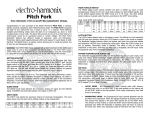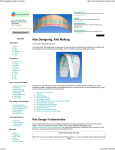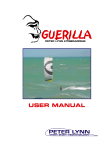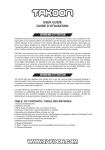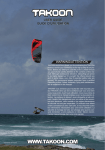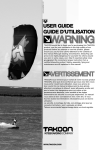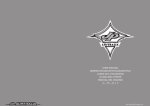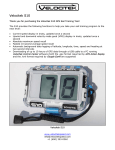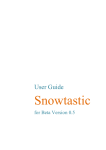Download Kitesurfing Handbook - Kite Club North Goa
Transcript
Kitesurfing Handbook www.kiteclubnorthgoa.com Basic kitesurfing techniques are consisting of: 1. Kite piloting, launching and landing 2. Kite power controlling 3. Body dragging 4. Getting into the water 5. Getting ready 6. Water starting 7. Get going 8. Steering the board 9. Going upwind 10. Jibing 11. Toe-down riding 12. Kitesurf in an overpowered situation 13. Kitesurf in an underpowered situation 14. Beach starting 15. Jumping 16. Landing 17. Looping 18. Tricks 19. Wave Riding 20. Extreme Conditions These are the basic techniques in kitesurfing. Once you've mastered them, invent your own moves… The sky is the limit! Kite Piloting, Launching and Landing To be a kitesurfer, you have to be a good kite pilot. Practice with a trainer kite before getting your kitesurf kite. Most trainer kites are 2 line foil kites. You launch and land the trainer kite using the launching and landing instruction for foil. Also, you turn the kite to the left by pulling on the left end of the control bar and turn the kite to the right by pulling on the right end of the control bar. If you have never flown a trainer kite, read the Control Devices section of the Equipment page for information. Different kites have different launching, landing and water relaunching techniques. We assume that you can get such information directly from your kite vendor. If you are using traditional inflatables, flat inflatable or foils, you can use the following self launching and landing instructions: Kite Launching and Landing Launching Traditional Inflatable (on land or snow): 1. Put the kite down on sand, leading edge toward the wind, one tip of the kite is on the sand the other tip is in the air. The kite looks like a vertical "C" with the leading edge facing the wind. 2. Fold the kite tip and put enough sand (or snow) on it to keep it from moving around. 3. Hold the control bar and position yourself such that kite is at the wind window edge respective to your position (the kite is around 70, 80 degrees to the left or the right of you with its leading edge facing the wind). 4. If you use a 4 line inflatable, adjust your trim strap to put the kite in a depowered mode. 5. Attach the safety leash to your wrist or harness. Don't hook in or shackle in to your kite until after you have launched your kite and get into deep water. 6. Pull on the control bar and the line nearest to the ground to unfold the tip and release the kite from the sand. 7. Pull the top line (the line farthest from the ground) to move the kite up. Drift Launching Inflatable (Traditional or Flat Inflatables): 1. Use this technique if you don't have enough space on the beach to launch your inflatable (also this is the safest way to launch an inflatable) 2. Inflate the kite and put it next to the water (make sure there is nothing on the sand that can damage your kite when you later on drag it on to the water) 3. Lay out your line and control bar and make sure they are properly attached with no tangles. 4. Attach the safety leash to your wrist or harness, hold the control bar and walk into the water. 5. Keep walking, swimming until you can pull the kite on to the water. 6. Let the kite drift down wind from you and water launch the kite. Water Relaunching Traditional Inflatable 1. Flip the kite: An inflatable kite is likely to crash in a leading edge down position. To get an inflatable to get into the vertical crescent moon position, the kiter first needs to get the kite on its back by swimming toward it. However, in strong wind, the pull of the kite is so strong that makes swimming toward the kite useless as the distance you swim toward the kite is easily absorbed by the pull of the kite. In such case, it is necessary to pull on the middle leader line (which is connected to the front lines) of the kite while swimming toward it. After you have pulled in around 2m of the middle leader line, suddenly release it and hold on to the control bar. The kite will immediately get on to its back. The other method is to pull the bar back over your head and suddenly push the bar rapidly in front of your body. 2. Fly one tip: Select 1 tip of the kite as a top tip and try to fly it by pulling on the back line on the same tip. 3. Pull the bottom tip: Once the top tip has caught the wind, keep pulling the bottom tip (or the line which is attached to the tip of the kite nearest to the water) until the kite slides toward the edge of the wind window 4. Launch: Pull on the top line (the line attached to the tip of the kite farthest from the water) to launch the kite. Self-Landing Traditional Inflatable in Shallow Water: 1. If you are hooked in (or shackled in) to the chicken loop, adjust the trim strap to put your kite in a depowered mode and then unhook before getting in shallow water near land 2. It's best to land the kite in shallow water as it is both safer and easier (this method still work on land even thought it is slightly more dangerous on land) 3. Move the kite to the left/right edge of the wind window near or ground (if the safety leash is attached to the left side of the kite then move it to the right edge; other wise, move it to the left edge) 4. Drop the bar, pull on the safety leash (which should be attached to the upper side of the kite - either front line or back line) 5. Hold the line which the safety leash is attached to and keep walking toward the kite until you catch the leading edge of the kite (optionally you can release the safety leash before walking toward the kite). 6. Put the kite on the beach, secure it and then grab the control bar and wind the line in. Self-Landing Traditional Inflatable on Land: 1. If you are hooked in (or shackled in) to the chicken loop, adjust the trim strap to put your kite in a depowered mode and then unhook before getting in shallow water near land 2. Move the kite to the left/right edge of the wind window near or ground (if the safety leash is attached to the left side of the kite then move it to the right edge; other wise, move it to the left edge) 3. Drop the bar, pull very fast around 2 or 3 m of the safety leash. The kite should drop nicely on the ground in the same position where you normally place it (leading edge on the ground, back facing the wind, the wind secures the kite on land) 4. Hold on to the line where the safety leash is attached to, walk toward the kite and put sand on it (optionally you can release the safety leash before walking toward the kite) Launching Flat Inflatable (on land or snow): Use the same launching method as traditional inflatable Or: 1. Anchor the chicken loop to a heavy object (your snowboard, kiteboard or a heavy bag of sand). 2. Go to the kite and launch it at the edge of the wind window. The kite will just hover there with little or no pull. 3. Go back to the control bar and attach the safety leash 4. Attach the chicken loop to you harness 5. Pull the top line (the line farthest from the ground) to move the kite up slowly. Water Relaunching Flat Inflatable: Use the same water relaunch method as traditional inflatable Or: 1. Keep pulling on 1 back line until that side of the kite raise to form a vertical "C" 2. Release the back line and the kite start to slide toward the wind window edge 3. Pull on the upper back line to launch the kite off the water 4. Sheet out to depower, the kite will fly up with very little pull Self-Landing Flat Inflatable in Shallow Water: 1. Move the kite to the window edge. Release the bar, the kite will just hover there with almost no pull 2. Detach the chicken loop and quickly pull in 1m or 2m on the upper front line, the kite will drop leading edge toward the wind 3. Walk toward the kite while holding the same line (upper front line) until you catch the leading edge of the kite (optionally you can release the safety leash before walking toward the kite) 4. Put the kite on the beach, secure it and then grab the control bar and wind the line in. Self-Landing Flat Inflatable on Land: 1. Move the kite to the window edge 2. Release the bar, the kite will just hover there with almost no pull 3. Detach the chicken loop and quickly pull in 1m or 2m on the upper front line, the kite will drop leading edge toward the wind 4. Walk toward the kite while holding the same line (upper front line) until you catch the leading edge of the kite (optionally you can release the safety leash before walking toward the kite) 5. Put the kite on the beach, secure it and then grab the control bar and wind the line in. Launching Foil: 1. Lay your kite on the ground and put enough sand/snow on its trailing edge to keep it in place. 2. If you use a closed-cell foil that has pre-inflation valves, open them now to pre-inflate the kite. Once the kite is properly preinflated, close the pre-inflation valve. Release the lines from you control bar or handles and attach your safety leash to your harness or wrist. 3. Launch the kite. If you are using a closed cell foil, you may want to maintain the tension on the front lines to let the wind fill the kite for approximately 60 seconds before launching. 4. If the kite is not completely inflated, move it across the wind window a few times before moving it straight overhead. Water Relaunch Foil: 1. Water relaunch a foil is easy. The foil will either crash leading edge down or trailing edge down. 2. If the leading edge is down, just pull on the brake lines (back lines) to reverse relaunch the kite. 3. If the trailing edge is down, just pull on the control bar or the front lines to launch the kite. 4. If the kite is badly mixed up, just wait for the wind to blow the kite in to proper shape before using step 2 or 3 depending on the position of the leading edge and trailing edge (don't pull the kite in this case) Landing Foil: If the foil has proper safety release system, to land a foil simply drop the control bar or handles, the kite will land softy down straight ahead. Kite Piloting Practice with your trainer kite on land at least a couple times before attempting to kitesurf on the water. The best wind to practice with your trainer kite is 7-20 knots and for a small kitesurf kite is around 7-10 knots. 7 - 10 knots is the wind speed where a small kitesurf kite can fly and generate pull but not too much. Also, use shorter lines around 10 to 20m while practicing on land. You need to master the following (before practicing your kitesurf kite, make sure that you have read and fully understood the safety guidelines and self-rescue techniques): 1. Turn the kite to the left. 2. Turn the kite to the right. 3. Do a number of figure 8's in the left side of the wind window (the figure 8 is slanting 45 degrees; the top is at zenith, the bottom is at the left edge). 4. Do a number of figure 8's in the right side of the wind window (the figure 8 is slanting 45 degrees; the top is at zenith, the bottom is at the right edge). 5. Do a number of sine wave patterns (up down up down, etc.) while running to the left 6. Do a number of sine wave patterns while running to the right. Make the kite hover at the left edge of the wind window at 45 degree vertically while running to the left. 7. Make the kite hover at the right edge of the wind window at 45 degree vertically while running to the right. 8. Lie on the ground with the kite hovering at zenith; dive the kite down to the left and use the kite lift to get yourself to a sitting up position. Do this a number of times. 9. Lie on the ground with the kite hovering at zenith, dive the kite down to the right and use the kite's lift to get yourself to a sitting up position. Do this a number of times. Also read the kite user manual as it has additional kite flying skills that you may want to practice. If you do not know how to control your kite, read the Control Devices section of the Equipment page. Repeat these steps until you can do them without permanently looking at your kite (e.g., keep your eyes closed temporarily and try to "feel" the kite). Practicing with the kite in light wind on land: "Make the kite hover at the right edge of the wind window at 45 degree vertically while running to the right". This may be a good time practicing with your harness system. Just make sure that you try it with a trainer kite or in less than 8 knots of wind with your small kitesurf kite (or better yet, do this in shallow water): 1. Hook in and try to control the kite with only your left hand holding the bar. 2. Hook in and try to control the kite with only your right hand holding the control bar. This may be a good time to try the safety release system associated with your control device to make sure that it works. If the kite and the control device do not come with a safety release system, send a message to the Kitesurfing School and/or Kitesurfing mailing lists. Someone may be able to help you there. As a beginner, never attempt to learn how to kitesurf alone without a safety release system. Kite Power Controlling Before attempting to kitesurf in the water, you need to understand some of the fundamental techniques about controlling the power of the kite. Lift is proportional to the projected sail/kite surface and the square of the apparent wind speed. Therefore to control the power of the kite, one needs to know to control the projected surface and the flying speed of the kite. There are a number of ways to control the power of a kite. You should understand them all and use the ones that you are most comfortable with. Projected surface controlling Projected surface controlling is the method used mostly in traditional sailing (including windsurfing) to reduce the power of the sail by reefing (manually or automatically), by sheeting out or by tilting the sail to windward (in windsurfing) or leeward (boat sailing). If you are using a kite that allows depowering of the kite by shortening the front lines (or the center leader line which is adjustable by a strap or a "chicken loop") to change the angle of attack of the kite (therefore changing the projected surface), practice it now. Fly the kite across the wind window and attempt to depower the kite a number of times to be familiar with the process and feel the reduction in power. The most common way to depower the kite in this case is to hook-in the chicken loop (which is connected to the front lines) and then move the bar away for less power and pull the bar toward your body for more power. If you are using a 4 line foil kite that allows depowering of the kite by pulling or releasing the center line to change the shape (therefore changing the projected surface) of the kite, practice it now. Fly the kite across the wind window and attempt to depower the kite a number of times to be familiar with the process and feel the reduction in power. One of the biggest advantage of the projected surface control method is such that you can lock the kite at a certain angle of attack or projected surface. This feature widen the wind range of the kite and allow the kitesurfer to be more confident to kitesurf in a more powered up conditions (as the kitesurfer can quickly lock the kite into a smaller projected surface in overpowered conditions). Speed Controlling Speed controlling is the method to decrease or increase the power of the kite by controlling its flying speed. This feature is uniquely available to kite sailing and often overlooked by many experienced traditional sailors. Since lift is proportional to the surface and the square of the apparent wind speed. Controlling the speed of the kite likely to be the best way to control the kite power. The main method is the "fly the kite" method which is probably the easiest, safest and available to all kites. The principle behind this method is simple. It's difficult to reduce the power of the kite (especially for a 2 line kite) and very easy to increase the power of the kite by simply "flying" it. When a kite "flies" across the wind window, it could generate 2, 4 or 10 times the "stationary" force (at the edge of the wind window). So when you want more power from the kite, simply fly in a "sine wave" or "up & down" pattern. The advantage of this method is such that the kitesurfer is always in control and with a high skill level, the kitesurfer can generate fairly "smooth" continuous power regardless of how fluctuate the wind is (a feast unachievable by any other sailing craft). Furthermore, as all intermediate and advance kiters know that via this speed controlling power generation technique that generate enough force to lift the kitesurfer off the water during a jump. It's best to use all of these methods to control the power of my kites whenever it is appropriate. Being in full control of the power of your kite is important as it is both safer and give you more confident to kitesurf in a more powered up conditions (facilitate going upwind and jumping). Body Dragging Before proceeding with this section make sure you have mastered the following: 1. You have read and fully understood the safety guidelines and self-rescue techniques. 2. Know how to launch your kite (information from your vendor or section 1 above) 3. Know how to water launch your kite in shallow (information from your vendor or section 1 above) water 4. Know how to land your kite (information from your vendor or section 1 above) 5. Know how to pilot your kite (section 1 above) 6. Know that your safety release system work (section 1 above) 7. Know how to control the power of your kite (section 2 above) As a rule of thumb, if you don't know how to launch/land a kite you want to buy and cannot get any launching, landing and relaunching instruction from your kite vendor (or such information is not covered in this web site), refuse to buy the kite as kitesurfing is dangerous enough and you definitely don't need the extra danger of not knowing how to operate your newly purchase kite properly. Try to practice body dragging at least a couple of times! Try to master the following: 1. Make sure that there is a "friendly" beach straight downwind from where you start. 2. Launch the kite and get in the water (or better yet, get in the shallow water and then launch your kite). 3. Use the kite's power to body drag yourself across the bay. 4. Do a number of figure 8 patterns in the left side of the wind window. 5. Do a number of figure 8 patterns in the right side of the wind window. 6. Do a number of sine wave patterns on the left side. 7. Do a number of sine wave patterns on the right side. 8. Land your kite in deep water and attempt to relaunch it (do this at least a couple of times). 9. Try your harness system. Try to control your kite while hooking in. 10. Also, read the kite user manual as it has additional body dragging skills that you may want to practice. Once you have mastered down-wind body drag, try to do upwind body-drag. Upwind body-drag is similar to normal body-drag except that you put the kite at the edge of the wind window (either left or right) and put 1 hand under the water to act as a keel to go upwind. Once you have learned how to body-drag upwind, you can retrieve your board without the help of a board leash. Getting Into the Water Now you are ready to learn how to kitesurf. The best wind to practice in is 10 to 18 knots using the kite size appropriated to your weight. Different kites generate different power. Your kite vendor should be able to provide you with a table describing which kite to use in a certain wind speed. When the kite is straight above your head, you should feel that the kite is lifting a small portion of your weight. If the kite is not lifting you up at all, you need a bigger kite. If the kite is lifting you up off your feet occasionally, you need a smaller kite. Get yourself ready in the water using the following steps (this method is written for a right-handed person with the safety leash attached to the left wrist or harness and the optional board leash - if you haven't yet know how to body drag upwind and still use a board leash attached to the right side of your harness; reverse the left/right designation for a left-handed person): 1. Launch the kite (some may prefer to do this in step 4) with the safety release line attached to your left wrist or harness. 2. Walk into the waist-deep water. 3. This step is not necessary if you already know how to bodydrag upwind. Attach the board leash to your harness (make sure you have a helmet if you use board leash). Your harness is the best place to attach the board leash . Attach a metal ring permanently to your harness. At the end of your board leash attach some large marine carabineer which you can easily attach or detach the board leash from the metal ring on your harness. 4. Launch your kite if you have not done so in step 1 (using the inflatable drift launching method described in section 1) 5. Use the kite power to drag you to deeper water (this step may not be necessary if you have plenty of space). If you don't use a board leash, control the kite with 1 hand and hold the board with the other hand. Getting Ready Now you are in the water holding the control device with the optional board leash attached to the right side of your harness. The wind is blowing from your back. Do the following steps to get ready for water starting (this method is written for a right-handed person – with the safety leash attached to the left wrist or harness - reverse the left/right designation for a left-handed person): 1. Hook the control bar to the harness and control the kite with the left hand (the safety release is attached to your left wrist or harness). The kite should be at zenith during the whole getting ready stage. 2. Grab the board with your right hand. If going to the the board by the back foot strap/binding. If going to hold the board by the front foot strap. If there is handle at the center of the board then grab the board left, hold the right, a board handle. 3. For a directional board or bidirectional board with straps, insert the left foot first then insert the right foot. The right hand should only release the board once the right foot is about to insert into the strap. 4. It is slightly more complex and difficult if you use high wrap binding as high wrap binding require both hands to get into (this is why modern kitesurfers normally do not use binding). It's best to use binding that require only one hand (straps and bungee or sandal binding). You are now ready to go to step 1 of water starting. Getting ready for water starting with a skim board (no strap) Water Starting At this stage, you should have the control device hooked in to your harness; both of your feet are in the foot-straps or bindings; the board is in front of you and the wind is blowing from your back. For a bidirectional board, if the board is behind you, simply sink it under your body to move it to the front. The board should not have a lot of volume; otherwise it would be very difficult to do so. The other option is to use the power of the kite to lift you slightly off the water to move the board in front of you (by moving the kite slightly forward to 75 degrees vertically then suddenly move it upward/backward to 85 degrees vertically backward) Water start to get on your board using the following steps: 1. Move the kite slightly backward. 2. Dive the kite forward (the depth of the dive is dependent on the wind and your weight – the deeper you dive the kite the more power it generates). At this stage it is better to be underpowered and fall backward than to be overpowered and fall forward. Once you fall forward, you have to start the Getting Ready stage all over again! 3. Try to get on the board when the kite is at the middle of the flight path. 4. If not successful, repeat step 1 (this time, move the kite slightly more backward in step 2). 5. Once on the board, press slightly on the front foot and move the kite upward (it is best to move the kite up as soon as you start planning on the board). 6. If the board starts sinking, you are loosing the balance or the kite pulls too much upward, bend your knees to move the body more to the center of the board (this will lower your center of gravity to have more balance) 7. When the kite reaches a good height (75 degrees vertically), dive it down forward to generate pull. If you are loosing balance, dive the kite down sooner (once it reaches 60 to 65 degrees vertically). 8. When the kite starts pulling, lean the body backward. 9. If you are a windsurfer, this step should be fairly easy. You should be able to get on your board after a couple of tries; however, to stay on the board and keep it planning requires more practice. Get Going Congratulation! You have just completed your first water start. However, to stay on the board and get going will require much more practice. To keep on going use the following steps: 1. If the wind is strong, you can keep going by locking the kite at 35 – 45 degrees vertically in a forward moving position. 2. If the wind is not very strong (the board slows down, the pull of the kite becomes weaker), you need to move the kite up & down (in a sine wave pattern) to generate more pull. Move the kite up and down using the sine wave pattern within 15 to 75 degrees vertically. Remember to move the kite up as soon as you are on the board. 3. As a general rule, bend your knees to have more balance to stay on the board. 4. You are likely to be able to stay on the board only for a couple of seconds in the first few times. Do not be discouraged. You need practice to be able to keep balance on the board and control the kite at the same time to generate constant power to keep you on the board. More kite piloting training will definitely help. 5. Do not look down on your board too often. Keep your eyes on the kite most of the times as it is much more nervous than your board. Naturally, you can "feel" your board much better than you can "feel" your kite in the beginning. Just try to balance yourself on the board with the pull of the kite and just let your board "go". In the beginning, do not attempt to steer your board; just let it naturally "go". 6. When you feel that the pull of the kite is too strong, lean backward and edge the windward rail of the board to counter balance the pull of the kite. 7. At this stage you will go downwind very fast. Just let your board "go" and do not attempt to fight it. What you want to achieve now is just to be able to stay on your board and just "get going". Just make sure there is a friendly beach straight down wind from where you started and prepare to have a long walk back at the end of your run. Do this until you can get on your board and "go" each time. Practice this in both directions: going out and coming back. Steering the Board Once you are able to stay on your board and "go" for an extended length of time in both directions a couple of times, you can start thinking of steering your board. Steer the board using the following techniques: 1. To steer the board downwind (away from the wind, leeward), flatten the board and press more on the front foot. Your body may need to be shifted slightly toward the front of the board. 2. To steer the board upwind (toward the wind, windward), edge the windward edge of the board - keep the windward rail slightly under the water - and press slightly more on the back foot. The more you edge the windward rail and press on the back foot, the more the board will go upwind. 3. You will need strong pull from the kite to assist going upwind. So you only be able to do this with the kite locked in at 35 to 45 degrees vertically on a strong wind day or while the kite is diving down. 4. Do a couple runs across the bay and practice your steering. You may want to coordinate your kite movement with your steering. When the kite moves up, steer your board slightly downwind. When the kite moves down, steer your board upwind. Practice this until it becomes "natural" (i.e. you can do it without having to think about it). Going Upwind Going upwind using the following techniques: 1. If the wind is strong, just lock the kite in at 30 – 40 degrees vertically, edge the windward rail and press slightly more on the back foot. The board will go upwind. If you are going too much upwind and the board starts loosing speed, you may need to temporarily steer the board downwind to gather speed before steering the board back upwind. 2. If the wind is not strong, you need to make the sine wave pattern with your kite. When the kite goes up, you should steer the board slightly downwind to gather speed and when the kite goes down, you can steer the board upwind. The board will make a figure S, which goes downwind then upwind, where the upwind leg is more pronounced such that you will end up going upwind. Click here to view a photo sequence of the sine wave pattern. 3. Turn your upper body to face the direction where you're going. This position helps your legs to turn the board upwind and also allows you to see where you are going. You may have to turn your head occasionally (do not turn your whole upper body) to look at your kite. When you turn your board upwind, always edge the windward rail 30 to 45 degrees to the water and lean your body 45 degrees backward. 4. When the wind is strong, the pull of the kite will make you go downwind. Do not let that happens. If you are hook-in to the chicken loop, just move the bar away to ease the power. If you are not using the chicken loop, you have to fight that pull with all you have: your weight, your muscles and your board. Let the kite carry your entire weight; use your legs to edge the board very hard and turn it way upwind. If you fight hard enough, your board will slow down and the kite will "reach" the edge of the forward wind window. Once it's there, the pull will lessen and you can control both the board and the kite better if you keep on going in the same upwind direction. 5. To be able to go upwind does not mean that you can come back to where you start. Each time you fall, the kite may pull you around 20 to 50 m downwind. If you are using a directional board, you have to master the going upwind technique and nail 40 - 50 percent of your jibes before being able to come back to where you start. Jibing Bidirectional board jibe: Jibing on a bidirectional board should be very easy as you don't have to complete the jibe and simply fake it to complete the jibe (this is one of the main reasons why most modern kitesurfers use bidirectional boards). Furthermore as you don't have to change feet, the successful rate is much higher than on a directional board. Use the following steps to jibe a bidirectional board. Toe Turn Jibe: 1. Press slightly more on the front foot and keep the board flatter to go downwind. 2. Move the kite backward/upward. 3. Press on the downwind rail (press your toes) of the board to carve it down wind. 4. When the board is almost straight down wind and the kite is almost straight overhead, press on the back foot and the windward rail to slide the board down wind. The back foot will now ready to become the front foot. 5. Dive the kite in the new forward direction to get going. Jump Jibe: 1. Bend your knees, jump up and switch your board around; you will be riding toe-down now. 2. Move the kite upward and turn your board downwind 3. Shift your weight more to the heels 4. Dive the kite in the new direction and press your heel to carve the board to the new direction Heel Turn Jibe: 1. Move the kite upward and turn your board upwind 2. Shift your weight more to the front foot and start turning the board downwind with the back foot becoming the new front foot 3. Dive the kite in the new direction and press on the "upwind rail" (press your heel) to carve the board to the new direction Directional board jibe: For directional boards, there are a number types of jibe. We will discuss three most common types: windsurfing jibe, snowboarding jibe and pre-jibe (or front-jibe). When you do a windsurfing jibe, you depower the kite my moving it almost to zenith and then change feet while the board is almost flat and straight down-wind. When you do a snowboarding jibe, you use the power of the kite to carve the board continuously and then change feet when the board is fully going in the new direction with proper edging. In pre-jibe or front-jibe you change your feet before turning the board around. Windsurfing Jibe: 1. Press slightly more on the front foot and keep the board slightly flatter to go downwind. 2. Move the kite backward/upward to 80 to 85 degrees vertically in the other direction. 3. Take the back foot out of the foot strap and press on the downwind rail of the board to turn it. Once the board gets pass the wind arrow (the board starts moving in the other direction), move the back foot just behind the front foot straps with toe pointing downwind. 4. Remove the old front foot off the front strap, turn your body and put it just in front of the back strap (toe pointing down wind). Step 4, 5 and 6 have to be executed with "lightening" speed; otherwise, the board will slow down too much and sink. 5. Slide the new front foot into the front strap. If you get to this point your jibe is completed, the rest is just "cosmetics" (I sailed very often with my back foot placed just in front of the back strap). 6. Slide the new back foot into the back foot strap (you can execute this step after step 8). 7. Dive the kite in the new forward direction to get going. Snowboarding Jibe: 1. Press slightly more on the front foot and keep the board slightly flatter to go downwind. 2. Unhook from your harness. 3. Move the kite backward/upward to 60 to 70 degrees vertically in the other direction. 4. Take the back foot out of the foot strap and press on the downwind rail of the board to turn it. 5. Carve the board around completely such that you are now sailing in a toe down position (you should be able to keep going with this position for a while if the water is choppy). 6. If you are overpowered, move your kite up slightly to 80 degrees vertical (this step is normally not needed unless you are way overpowered or not experienced enough) 7. In one continuous movement: move the old back foot just behind the front footstraps (toe pointing down wind); with the new front foot continuing to edge the new windward rail, remove the old front foot off the front strap; while turning your body, push the board forward (this push is very important) with the new front foot and then place the new back foot (old front foot) just in front of the back strap (toe pointing down wind); slide the new front foot into the front strap. 8. If you get to this point your jibe is completed, the rest is just "cosmetics" (I sailed very often with my back foot placed just in front of the back strap). 9. Slide the new back foot into the back foot strap (you can execute this step after step 8). 10. Dive the kite in the new forward direction to get going. Windsurfing jibe is easier for a beginner; however, snowboarding jibe is easier for a more advanced kitesurfer when the condition is tough (high wind, choppy water, etc.) Pre-Jibe or Front-Jibe: There is another type of jibe - call pre-jibe or front-jibe - that was very popular with the Hawaiian in the early days. The whole idea behind the pre-jibe method is trying to get in to your favoured stance as soon as possible. Learning how to jibe a directional in kitesurfing is actually much easier than in windsurfing. An average kitesurf should be able to nail the first jibe on a directional after 5 to 10 hours of practice. However, to nail 80 to 90 percent of your jibe may take longer. Toe-down Riding: Toe-down riding is a technique that you must master if you kitesurf on a 2 strap directional board with a special front strap set up that you can't switch feet. This technique is also recommended for a "jibeable" directional board or a bidirectional board kitesurfer. It is a very useful technique to learn if you want to do the snowboarding jibe and especially if you want to do wave kitesurfing. Besides, a good all around kitesurfer should be able to kitesurf with all types of board. To get into a toe-down position, you normally have to get going in a heel-down position and then turn the board around. Use the following steps to turn from a heel-down to a toe down position: 1. Press slightly more on the front foot and keep the board slightly flatter to go downwind. 2. Move the kite backward/upward to 60 to 70 degrees vertically in the other direction. 3. For a 2-strap board, just use your toes to press on the downwind rail of the board to turn it (more weight on front foot to start the turn). For a large 3-strap directional board, take the back foot out of the foot strap and press on the downwind rail of the board to turn it. 4. Carve the board around completely such that you are now sailing in a toe-down position. 5. Dive the kite in the new forward direction to get going. Now you are in a toe-down position, just keep going until you want to change direction. Use almost the same technique to change from toedown to heel-down riding. If you are riding on a large 3-strap directional board, move the back foot to the center of the board in step 3 before carving the board around: 1. Press slightly more on the front foot and keep the board slightly flatter to go downwind. 2. Move the kite backward/upward to 60 to 70 degrees vertically in the other direction. 3. For a 2-strap board, just use your heels to press on the downwind rail of the board to turn it (more weight on front foot to start the turn). For a large 3-strap board, move the back foot to the center of the board to turn it (the front foot actually makes the board turn). 4. Carve the board around completely such that you are now sailing in a heel-down position. 5. Dive the kite in the new forward direction to get going. 6. If you are riding on a 3-strap board, you may want to insert the back foot into the back strap. 7. If you have never done wakeboarding or snowboarding, this is an achievement. Congratulation! Kitesurfing in an Overpowered Situation No matter how you select the size of your kite, sooner or latter, you will encounter a situation when you are completely overwhelmed by the power of your kite. If you are using a 4-line inflatable kite, you can depower the kite by sheeting out (hooking into the chicken loop and moving the control bar away from you, which will change the angle of attack of the kite). If you don't use the chicken loop, you are fully depowered, or you are using a 2 line kite (no depowering capability), the situation is much more difficult. The only way you can lessen the pull of your kite is to fly it near the edge of the wind window. There are only two places where you can fly the kite to lessen its pull: near the upper edge and near the forward edge of the wind window. You can lessen the power of your kite by flying it near the upper edge of the wind window. However, the highest angle you can fly your kite is around 70 degrees vertically. Beyond that, the kite will tend to lift you up and make it harder to go upwind. So if you are overpowered and want to go down wind, just fly the kite higher (70 to 75 degrees vertically) The second way to lessen the pull of your kite is to fly it at the forward edge of the wind window. It is easy in theory; however, to get the kite to the forward edge of the wind window in an overpowered situation is a major achievement. Normally, when the kite pulled, it's in the middle of the flight path to the forward edge of the wind window. If you yield to the pull and go down wind, the kite and the board will travel fast (probably at the same speed) down wind such that the kite is constantly in the middle of the flight path to the forward edge of the wind window. It's a vicious circle: the more the kite pull, the more you go down wind, the more the kite will continue to pull (because the kite would never be able to get to the edge of the wind window). It's worst when you are in an overpowered situation; you will move down wind faster in a constant overpowered situation! The only way to "fight" the pull of the kite is to go upwind. Fight the kite's pull with whatever you have: your weight, your muscles and your board. Let the kite carry your entire weight; use your legs to edge the board very hard and turn it way upwind. If you fight hard enough, your board will slow down and the kite will "reach" the edge of the forward wind window. Once it's there, the pull will lessen and you can control both the board and the kite better if you keep on going in the same upwind direction. Don't point your board downwind or move your kite to get into another overpowered situation. You will be in for another upwind fight again. Going upwind is the best way to kitesurf in an overpowered situation. Keep your kite between 10 to 30 degrees vertically. In this position, the kite will help you to edge the windward edge of the board more effectively. Kitesurfing in an Underpowered Situation No matter how you select the size of your kite, sooner or latter, you will encounter a situation when you are a couple of miles out in the open water and the wind drops. You simply do not have enough power to kitesurf. Use the following techniques to get yourself to shore with some decency: 1. Unhook from your chicken loop and only use the fixed loop. You can get much more power from the kite that way. 2. If the underpowered situation is temporarily (e.g. a lull), simply drop your body backward into the water. While in the water, edge the windward rail of the board. Your body and the board will create some resistance such that you will not be drifting downwind fast by the pull of the kite. 3. If it seems like the wind is too light, go downwind. The best way to kitesurf in very underpowered situation is to go downwind. 4. Bend your knees and move your body closer to the center of your board. Move the kite continuously to generate power. Use the figure 8 pattern for more power and use the sine wave pattern for less downwind drift. 5. If the wind is too light for riding, you can body-drag back to land. In this case, you may want to hold your board and use it as a keel to make body-drag upwind more efficient. Beach Starting Beach starting is an advance move in kitesurfing. Try beach starting only when you are very comfortable with your equipment. Standing Beach Starting: 1. Hook in and control the kite with one hand. 2. Grab the board and move it to the front with your free hand. 3. Insert the front foot into the front strap. 4. Grab the control bar with both hands, dive the kite forward and get the back foot into the back strap to get going. Jumping Beach Starting: 1. Hook in and control the kite with one hand 2. Grab the board with the other hand 3. Move the kite slightly toward the beach and then turn it quickly toward the water 4. As the kite lift you up, put your feet in the straps 5. Land and ride away Jumping You can jump fairly high in kitesurfing. Try jumping using the following steps: Dive the kite down to move the board very fast. Suddenly move the kite upward and backward to 85 degrees vertically in the backward wind window. Bend your knee and edge hard on the windward rail. When you feel the kite pulling you sufficiently (the same feeling as when you are overpowered), suddenly release the rail and extend you knee to jump. You should be airborne at this moment. While airborne, try to move the board in front of you and move the kite forward to have enough power to get going upon landing. Landing Landing smoothly consistently is somewhat optional in kitesurfing (especially when you are learning new tricks); however, it is a must in kitesnowboarding unless you want to break your bones. Landing smoothly also looks very stylist in kitesurfing so make sure you can do so all the time. Looping Looping or spinning is an intermediate kitesurfing move and you can perform looping in relatively small chop or wave. Back looping is actually easier in kitesurfing than in windsurfing. A good kitesurfer can normally perform a back loop after one year or two into the sport. You should have enough basic kitesurfing skills now to learn back looping all by yourself. Extreme Conditions Congratulation! You have mastered all the basic kitesurfing moves. Your next step is to invent your own new moves and try kitesurfing in extreme conditions: 1. Very light wind (less than 10 knots) 2. Very high wind (more than 30 knots) The owners, webmasters, authors and contributors of this site make no representation nor warranty regarding errors, missing of and correctness of the information contained in this manual. Use the information contained herein at your own risk. The owners, webmasters, authors and contributors are not responsible for any loss or accident to you or to other third parties including loss of business, loss of sale, equipment or property damage, injury or death resulting from you or other third parties using the information contained herein.





























